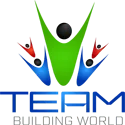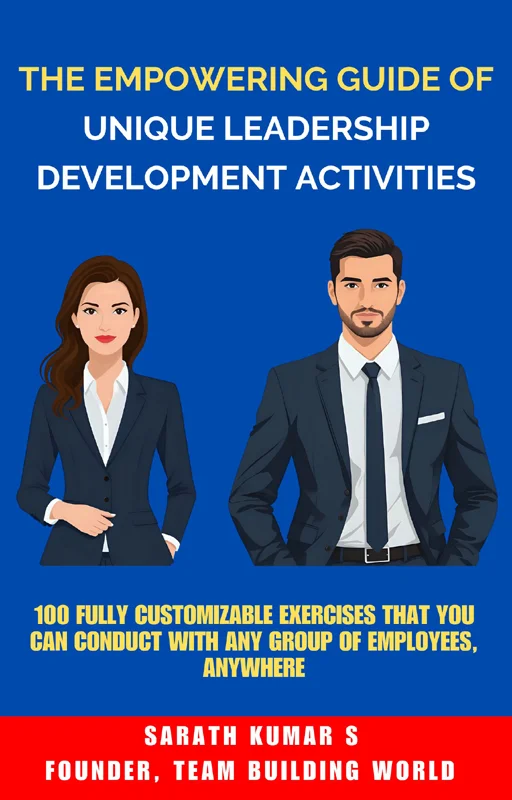10 Productivity Team Building Activities (With Debrief)
Are you in search of some productivity team building activities?
In any workplace, an efficient workforce is essential for success. As a leader, you should ensure that your employees are highly engaged, motivated, and productive.
In this article, let’s see 10 highly effective games you can try with your teams to improve productivity in the workplace. These activities can help your employees to be more productive.
10 Productivity Team Building Activities
Here are some productivity activities for your workplace:
#1. Escape Room Challenge
This is a thrilling, time-sensitive adventure that demands teamwork, and sharpens problem-solving abilities among employees.
Time: 15-20 minutes
Materials: A room with clues and puzzles
Participants: 3-8 individuals per group
Instructions
- Divide the employees into teams.
- Each team is locked in a room with clues and puzzles that they must solve to escape.
- The first team to escape within the time limit wins.
Debrief
Discuss what strategies worked, how the team communicated, and any challenges faced. Highlight how collaboration can increase productivity in the workplace.
You can also read: 11 Project Management Team Building Activities
#2. Productivity Trivia Game
The Productivity Trivia Game enhances the teams’ knowledge about the company’s goals and processes in a competitive way.
Time: 10-20 minutes
Materials: Trivia questions
Participants: 2-6 members per group
Instructions
- Prepare a list of trivia questions related to your company’s goals, achievements, and work processes.
- Divide the employees into small teams.
- Ask the questions in rounds, and keep score for each team.
- The team with the most points at the end wins a prize.
Debrief
Facilitate a discussion about the importance of understanding the company’s mission and how this knowledge can drive better teamwork. Highlight how being knowledgeable about the company can lead to increased productivity and success.
#3. Scavenger Hunt
This activity is designed to promote collaboration and problem-solving, turning the whole workplace into an interactive playground.
Time: 15-20 minutes
Materials: A list of items to find
Participants: Groups of 3-6 individuals
Instructions
- Compile a diverse list of items that can be found within your office environment.
- Divide the employees into groups, ensuring a mix of different departments if possible.
- Set a time limit for each group to find the items.
- The group that finds the most items wins.
Debrief
Reflect on how working together and utilizing each other’s strengths can lead to success in the workplace. Highlight the importance of teamwork in navigating complex tasks, reinforcing the value of diverse perspectives in achieving common goals.
#4. The Marshmallow Challenge
The Marshmallow Challenge is a dynamic activity designed to inspire creativity and innovation. Here the teams race against time to construct the tallest structure using simple materials.
Time: 10-15 minutes
Materials: 20 sticks of spaghetti, 1 yard of tape, 1 yard of string, and 1 marshmallow
Participants: Teams of 3-6 people
Instructions
- Provide each team with the exact amount of spaghetti, tape, string, and marshmallow.
- Teams have some time to build the tallest freestanding structure with the marshmallow on top. Example: A tower with a broad base for stability.
- Encourage iteration by allowing teams to test and adjust their structures throughout the building process.
- Measure the structures at the end of the time limit. The tallest one that supports the marshmallow wins.
Debrief
Highlight the value of experimenting and how initial failures can lead to innovative solutions. Discuss how this activity fosters a growth mindset, pushing participants to think outside the box.
#5. Design Thinking Challenge
The Design Thinking Challenge empowers employees to tackle problems with innovative solutions, fostering creativity and critical thinking. It is one of the amazing productivity team building activities.
Time: You decide
Materials: Paper, and pen
Participants: Groups of 3-8 people
Instructions
- Kickstart the session by defining a common problem that needs solving. Example: Improving the company’s remote work policy.
- Groups can brainstorm and jot down as many solutions as possible. Encourage out-of-the-box thinking.
- Each group can select the most promising solution and present it to the other groups.
Debrief
Focus on the process of identifying the most viable solution and the importance of diverse perspectives in enriching the brainstorming session. Talk about how structured problem-solving can lead to innovative outcomes even under tight constraints.
#6. Resource Relay
This exercise promotes quick decision-making and resource management skills. Here the employees race against the clock to complete tasks with limited resources.
Time: 15-20 minutes
Materials: A list of tasks and simple materials like paper, markers, straws, etc.
Participants: Groups of 3-6 people
Instructions
- Divide the participants into groups.
- Provide each group with a list of tasks and a limited amount of resources.
For example,
A) Build a tower using only 10 straws and tape in 3 minutes.
B) Design a logo with only markers and paper in 5 minutes.
C) Create a jingle using only 5 instruments in 8 minutes.
- Set a time limit and ask the groups to complete as many tasks as possible using only the given resources.
- The group that completes the most tasks within the given time wins.
Debrief
Identify how each team managed their resources and made decisions under pressure. Discuss the importance of quick decision-making, prioritization, and resource management in achieving goals in the workplace.
#7. Desert Island
This collaborative exercise tests problem-solving and decision-making skills as employees work together to survive on a deserted island.
Time: 10-20 minutes
Materials: A list of items
Participants: Groups of 3-6 individuals
Instructions
- Divide the participants into groups and tell them they are stranded on a deserted island.
- Provide each group with a list of 10-15 items they can use for survival. For example, food, tent, map, compass, etc.
- Explain that the group must work together to choose only 5 items within the time limit.
- Finally, have each group present their final list of chosen items and explain their reasoning.
Debrief
Discuss the different approaches each group took in selecting their items and how they worked together to make decisions. Emphasize how these skills can be applied in the workplace to improve productivity as a team.
#8. Deadline Dash
Deadline Dash is an interesting activity that replicates the pressures of managing a project under tight deadlines. It fosters time management and adaptability skills.
Time: You decide
Materials: Project brief, and timer
Participants: 4-8 members in a group
Instructions
- Assign each group a project to be completed within a short, predefined period. For example, create a social media ad script targeting millennials for a new product.
- Set the timer and instruct the groups to start working on their project.
- Announce halfway through that there is a new change in the project brief. For example, the product is now targeted towards seniors instead of millennials.
- Allow the groups to adapt and finish the project within the previously set deadline.
- Finally, have each group present their final project.
Debrief
Discuss how the groups managed the changes and time constraints. Emphasize the importance of adaptability in meeting deadlines and completing projects efficiently.
#9. The Priority Matrix Game
This game teaches employees how to prioritize effectively, delegate responsibilities, and work together towards a common goal while managing limited resources.
Time: You decide
Materials: Task cards, paper, and pen
Participants: 3-6 members per group
Instructions
- Divide the participants into groups and distribute the task cards to each group.
- Instruct the groups to categorize the tasks based on importance and urgency, using a priority matrix (e.g. High Importance/High Urgency, Low Importance/High Urgency, etc.).
- After they have completed their matrix, give them a limited amount of time to negotiate with other groups and determine which tasks can be delegated or shared for better efficiency.
- Have each group present their final priority matrix and discuss their decision-making process.
Debrief
Discuss the importance of effective prioritization, delegation, and collaboration in managing tasks and resources. Emphasize the impact it has on productivity and achieving goals within a team or organization.
#10. Word Association
This activity promotes creativity, teamwork, and productivity by challenging participants to make connections between seemingly unrelated words.
Time: 10-15 minutes
Materials: Whiteboard, and markers
Participants: Any number of people in a group
Instructions
- Write a random word on the whiteboard (e.g. “apple”).
- Ask one group member to say a word that they associate with the initial word (e.g. “pie”)
- Have the next member say a word that they associate with the previous word (e.g. “baking”)
- Continue until each person has had a turn or until the group reaches a predetermined number of rounds.
Debrief
Reflect on how each connection, from the first word to the last, represents a unique pathway of team thought. Highlight the importance of each contribution and how, collectively, they lead to unexpected and enriching outcomes.
Want Some Unique Leadership Development Activities?
If you want some unique activities to equip your employees with leadership skills, qualities, and mindset, you can get my new e-book:
Or Want Some Unique Team Building Activities?
If you want some unique activities for your employees (both in-person and virtual), you can get my new e-book:
Final Words
As a leader, it’s vital to inspire a culture of collaboration and innovation to increase workplace productivity. With the right activities and games, you can encourage your employees to communicate effectively, think creatively, and work together towards a common goal. Remember to regularly incorporate these activities into your team’s routine for continued growth and success.

